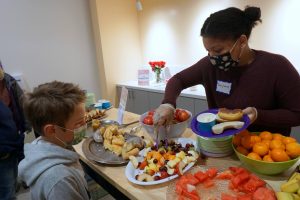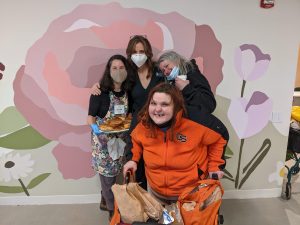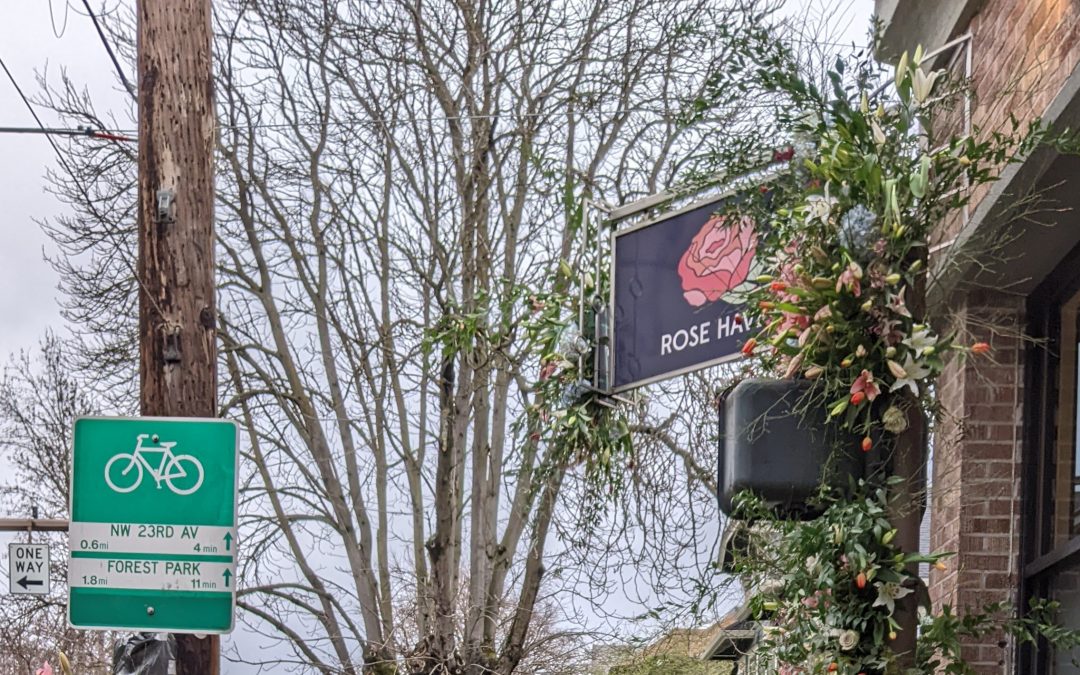
Jun 26, 2025 | Woman Owned Business
Did you know domestic violence is the leading cause of homelessness for women? Rose Haven is a trauma-informed day shelter for women, children, and marginalized genders. Its new space opened on March 8, 2022, after nearly two years of operating from tents in the COVID era.
PDX Local interviews Liz Starke, Development Director for Rosehaven.org.
As a day shelter, what services do you offer?
Rose Haven is a safe place designed with a trauma informed lens where you can go during the hours when many overnight shelters are closed. We offer a secure mailing address, access to meals, showers, restrooms, clothing, first aid, financial assistance and one-on-one advocacy for our guests. Most importantly, we offer community and dignity to a population facing extreme stigma and isolation. Currently, Oregon has the second highest rate of literally unsheltered people in the country- that is our neighbors living outside, in cars or in tents. All of the night shelters are full with wait lists, so we play an important role by bridging the gaps in services and offering help to all those folks not lucky enough to get a shelter bed. For example, if we had 40 beds that would mean we could help 40 people, in our model we are able to serve thousands of women and children a year.
What is the story of Rose Haven? How did it get started?
Rose Haven has been an important resource for women and children experiencing trauma in Portland for 25 years. We were founded in 1997 as a program of Catholic Charities after our founding director, Sr. Cathie Boerboom conducted a survey where she walked the streets of Portland and asked women what they needed. The overwhelming response was a safe place to go during the day, where they could take their children and access resources. Twenty-five years later we are still offering programs based off of our guests’ self-defined needs; offering a low-barrier and accessible community resource center where women can meet physical and emotional needs, access social services and find community. Although not a religious organization, Rose Haven operates under the Good Shepherd value system which embodies “Compassion”, “Individual Worth”, “Reconciliation” and “Zeal”.
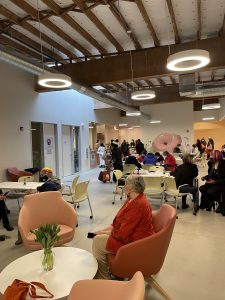
What special challenges do women and children face when they are homeless?
For women, it is especially dangerous to live outside and constantly be exposed. Women are sometimes referred to as “the hidden homeless”, because they go to great lengths to stay out of sight and not look vulnerable in order to stay safe. Domestic violence is the leading cause of homelessness for women, and unfortunately once they are outside they are even more likely to experience violence. This is why a sanctuary specifically for people marginalized by their gender is so important, because otherwise these women have to face their predators just to receive help in a co-ed space.
How have your mission and service offerings changed in the era of COVID?
COVID made our jobs really hard, but ultimately forced us to move into our dream home. Prior to the pandemic, we were functioning out of a very cozy ( some might call it cramped) church basement…where we were serving about 3,700 people a year- about 100 people a day! Needless to say we couldn’t socially distance in that space – so we had to make the really hard choice to push supply distribution to the sidewalk in order to keep our guests safe. For nearly two years we served up meals and clothing on the sidewalk, even doing first aid under a tent. Our guests only came inside to use the restroom, take a shower or meet one on one with a social worker – and for many this was their only opportunity to come indoors at all, as many agencies closed entirely during the lockdown. We knew Rose Haven was needed now more than ever before, and we had to expand. We launched a grassroots fundraising campaign and with the support of the community we opened our new home for the haven on March 8th 2022. We now have a beautiful 10k square ft facility that was designed with a trauma informed lens so our guests can feel at ease and heal when they are here. The visibility of our new location has brought attention to the issues our guests are facing and given them a home they can feel proud of.
What is the number one thing that people in Portland can do to make life better for our neighbors without homes?
Be compassionate. The most dangerous thing our guests face is stigma and isolation. They tell me they feel invisible and on display at the same time. It is so much easier to walk right past a person that is starving in front of you if you think of them as “other” than yourself. For example when you think of someone who is going through a hard time as a homeless person, rather than your neighbor that does something on a subconscious level to separate you from them. Unfortunately as more people are displaced, more of us know someone in our personal circle who has fallen on hard times, but we are not defined by our worst moments. I think the more we can do to bust myths (such as the magnet myth- which is the idea that people move out here to become homeless, when the truth is more than 80% of chronically homeless folks in Multnomah county went to high school here) and humanize our houseless neighbors, the better off we will all be. Just be kind to each other, and don’t be afraid of people if they are sick or hungry. Sometimes a smile can really change someone’s day, especially for someone who is used to being ignored or having people cross the street to avoid them.
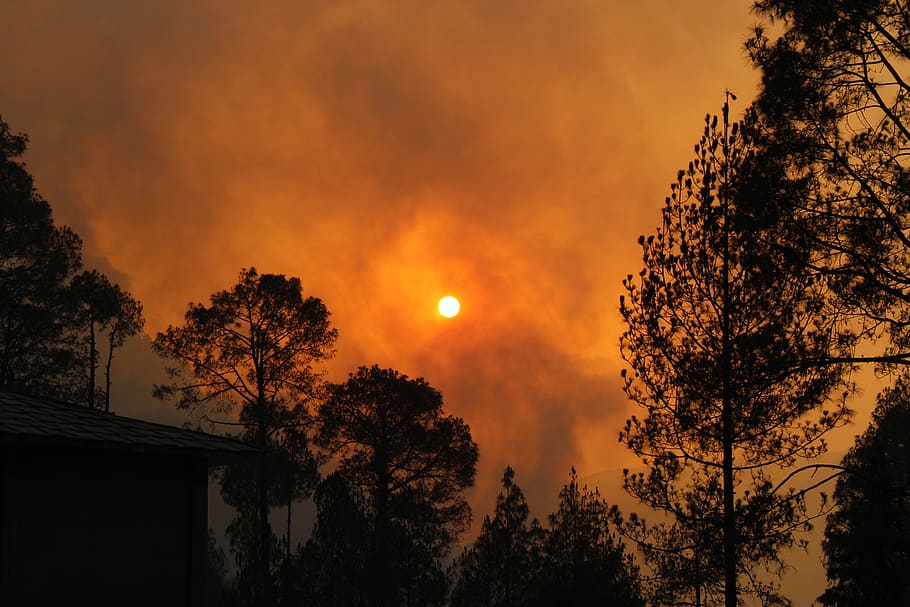
May 31, 2020 | Environment, Sustainable
I wrote this story at the end of March. Feeling a little bit alarmed that two months later, parts of this nightmare vision appear to be coming true. Ted Wheeler needs to do more to address the looming crisis of poverty and houselessness in this city. A night or two of curfew is not enough. The specter of riots and looting isn’t going anywhere, any time soon.
Imagining July 2020
by Rose C.
Successive waves of closures and reopenings have failed to stop the spread of Coronavirus, but left massive social and economic dislocation in their wake. Area hospitals have tents pitched around them, with patients being treated outside in cots. People are still lining up to get in. Grocery stores operate with armed guards outside the doors, due to periodic flare-ups of looting. Almost every other business is closed.
The National Guard has been called in to maintain order because local law enforcement is overwhelmed. A strict curfew is in place. Houseless people are being arrested and jailed. As a direct consequence, a large tent city of houseless people has grown up inside Forest Park. They are not bad people or criminals. They just don’t have anywhere else to go. Somebody has a weenie roast over a campfire. Sparks fly.
Soon all of Forest Park is in flames. The people camped there perish.
The sky darkens. The air is full of ash. Healthy people and sick people alike are choking, unable to breathe. Death rates skyrocket. The city will never be the same.
How can we avoid this fate? Very simple. Mayor Ted Wheeler needs to raise taxes and institute an emergency fund to house people and restore order. This special organization should have a different jurisdiction and coordinate closely with Multnomah County government. Distrust of the police is at an all-time high right now, but that doesn’t change the importance of the city delivering social services. It only increases the urgency.
We also need to ensure a better mechanism so that houseless / homeless people are able to vote in the fall elections.
As of a Portland, Oregon resident and taxpayer, I would gladly pay more taxes to keep my city safe in a time of need.
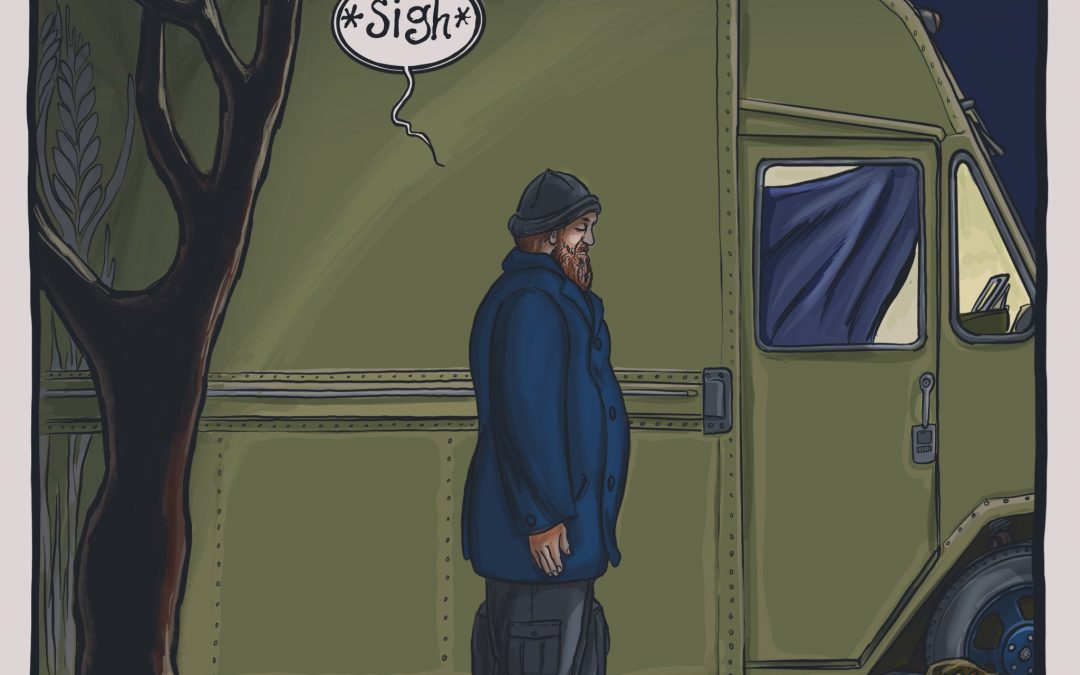
Jun 9, 2019 | Culture, Front Page, Local Business
Illustrator and puppeteer Geahk Burchill is homeless. That hasn’t stopped him from telling his story. A Portland resident for 18 years, and local to the St. John’s neighborhood since 2005, he spoke with us about his experiences and shared his newest project, a webcomic called Trucked Up.
How long have you been in Portland, Oregon?
I first moved to Portland, from Oakland, California, in May 2001 because of a sun allergy. I made the decision after getting a bad sunburn that February and felt like I could choose a place less difficult for me. I loved Portland instantly but didn’t have much savings. A minor fender-bender drained what saving I had and I spent a few months living in my VW van. Fortunately, I got work as a carpenter, and an apartment, relatively quickly. I had no idea it wouldn’t be the last time I was homeless.
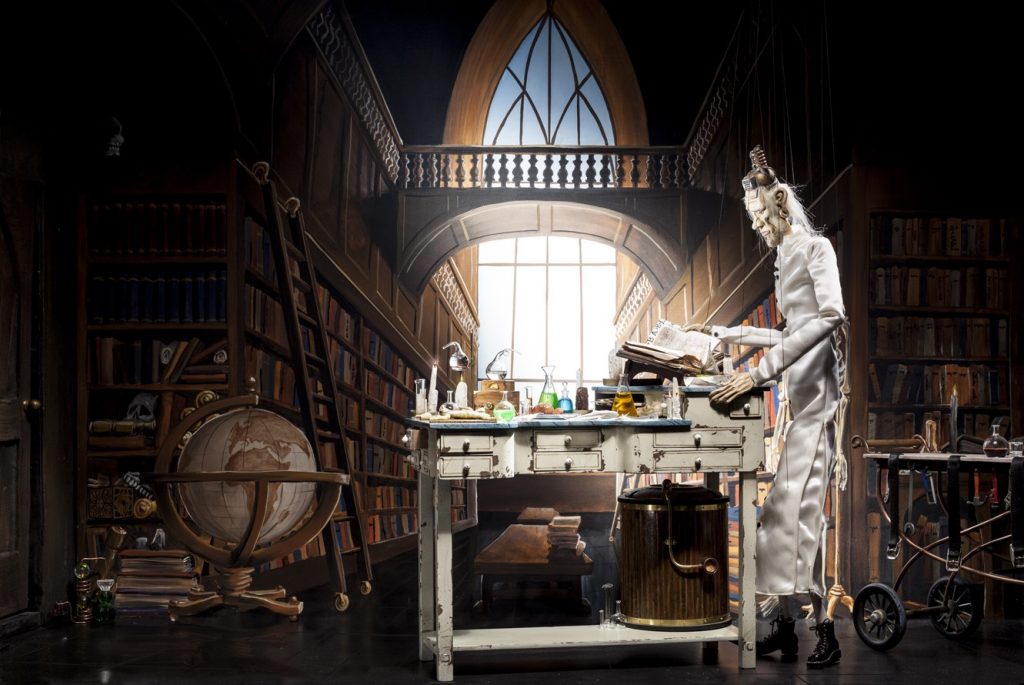
Dr. Hadrian in his Library. (Photo: David Emmite)
I moved to St. Johns in 2005 after starting a marionette company. I worked days for Michael Curry Design, and nights on my own puppets, building up a small theater company. In 2010 I left Curry to start my own design/build business and did reasonably well until about 2013 when I received less and less work. By 2014 I had a personal unraveling after working very long hours and losing money on multiple jobs. I let go of my house, first, and lived in my studio; in late 2017 I lost the studio as well. I converted the old puppet-truck into a live/work space and put everything in storage.
Describe your current living situation.
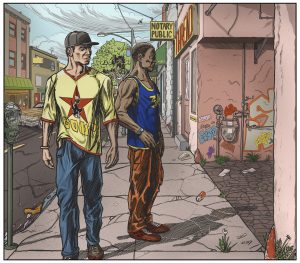
Oakland, where Burchill grew up.
I live in a decommissioned bread truck in which I built a bed, a kitchen, and work space. I took all the tools which used to make up my studio and made a condensed wood shop to try and continue getting work. For a long time I was parking on the street, moving the truck constantly, from spot to spot, to avoid cops. It made jobs difficult and I delivered projects late. That made it harder to get further work. It was also deeply demoralizing.The body of the truck is aluminum. In the summer it’s an oven inside, and a freezer now that it’s winter. In October the truck broke down and I had to have it towed. It’s now parked in the side yard of a friend, whom I pay to use utilities. Even at the amount he’s charging, I’m often late paying. It’s still a very unstable situation. I’m looking forward to repairing the truck, if I can, and having a bit more control over my life again.
Would you describe yourself as homeless?
I’m not sleeping rough. I’ve made my space as comfortable as I can. I have my cat, who sleeps on a heating pad, and my art desk, which I built to perfectly suit me. I have a microwave, and toaster oven, to make hot meals; an electric kettle for coffee. It’s about as cozy as homelessness can get but there’s a lot of room for improvement. It leaks in places. It was unsafe at times. Someone cut my gas line and stole fuel in the middle of one night while I was inside. It’s old and unreliable. At the same time, it represents a certain amount of freedom. I like the space despite its problems. I can see myself driving to jobs in the future and working out of the back.
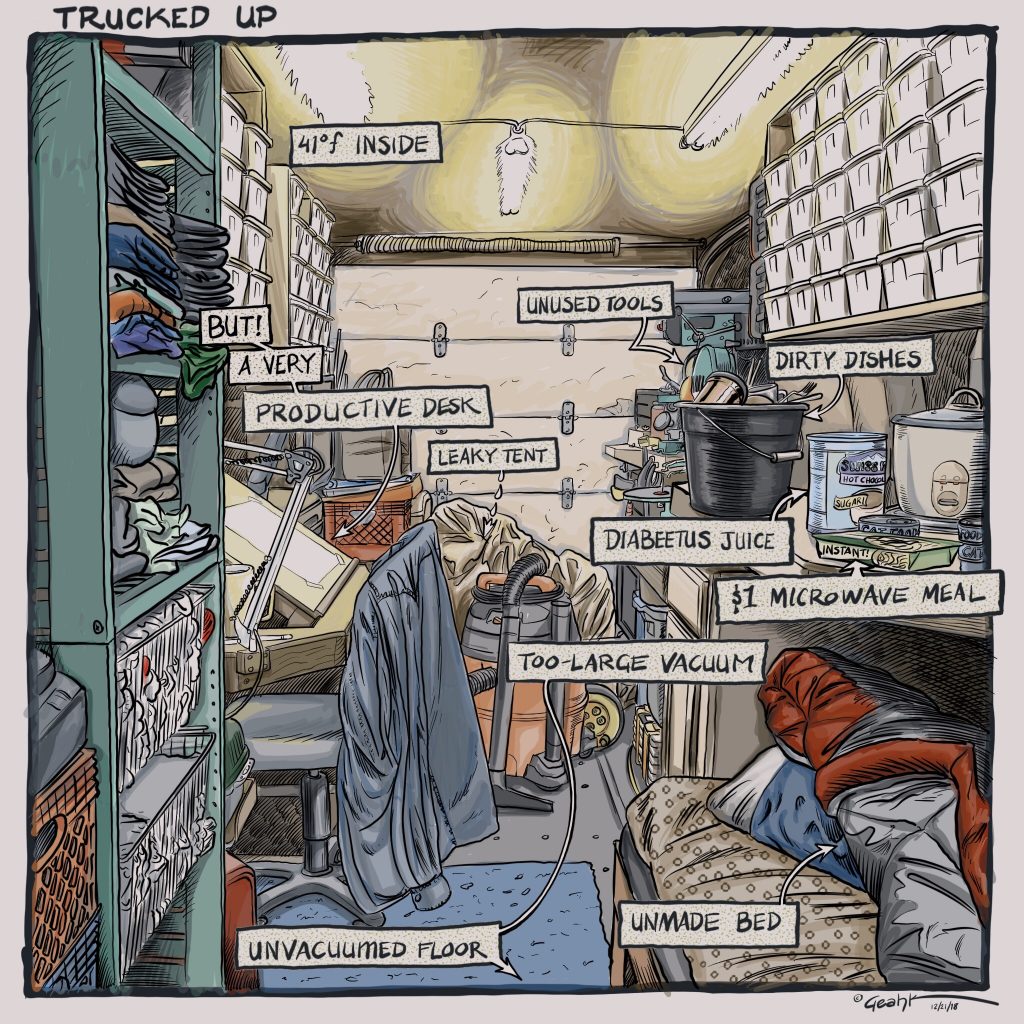
Your artistic style for the panels of “Trucked Up” is amazing. What is your process, and what tools do you use?
I started with traditional materials. I grew up poor and my medium was usually pen on copy paper. Five simple supplies. Paper, a good pen, a blue pencil, an eraser and a ruler. Later I began drawing with nib-pen on translucent vellum with India ink. That allowed me to sketch on cheap paper and then trace onto the expensive vellum with the nice dip pen for really crisp results.
I currently can’t do anything very messy in the truck, but I did an ad project a few months ago which earned me enough money to buy an iPad with Apple Pencil. I then recreated the way the vellum and dip-pen work in an app called Procreate. It allows me to be very portable and draw in cafes, where I can get wifi access.
Unfortunately, I bought the iPad just before the truck broke down. For a while I was kicking myself. It was a lot of money, but as I’ve kept drawing, I feel it was the only choice to keep me motivated and focused on the future. It’s become the tool I use for everything, including this comic I’ve started. I’m learning to animate and make videos for YouTube. It’s my connection to future work. A little bit of a security blanket too.
How has living in a truck impacted your artistic journey (thematically, pragmatically, etc.)?
Though I started drawing comics when I was fairly young, most of my career has been spent with sculpture and engineering. I’ve made puppets for nearly twenty years, including sewing the costumes, and painting the sets. In the truck I’ve been forced to narrow my focus to what I could accomplish in the space. Drawing and writing, mostly.
Even traditional drawing is hard to do in the truck. Ink gets too thick to use in the cold. My career has been built upon getting new work out often. It has to be in the internet age. Returning to comics is something I can accomplish with limited space, wifi, and access to power. It’s also a way to process the frustration and panic I frequently feel about my situation.
I’ve always talked about poverty, to one extent or another, in my work, but now it’s in sharp focus. I find so many situations that are darkly funny about the basic things I struggle with.
I have far more comic ideas than I’ll ever have time to draw. I’ve also wanted to do a video game which utilizes real scenarios I’ve found myself in as puzzle elements. So much of this is MacGuyvering my way through problems that come up. The comics are accomplishable though. Each one takes about five hours, which I can find time for. It’s a resource I have.
What’s next for “Trucked Up?”
I’ll keep drawing and posting to Instagram and Webtoons. I see there are some people who make decent money, once they get noticed, and build a following. I’m currently working on a mural for a client and that’s my main source of income, but it would be great if I could have something more stable and reliable. My income has been feast-or-famine for ten years, with almost constant stress. It would be nice to have some consistent money that I could plan for the future with.
I feel like I have a lot of ideas which extend beyond the scope of just living in the truck. I have a lot of life stories. Just the autobiographical content is enough for hundreds, or thousands of future comics, not to mention all the fictional stories I’d like to tell. Plus there are educational and instructional ideas I have. I’ve been teaching puppets over the years, and I can fold that into didactic drawings, maybe into a book.
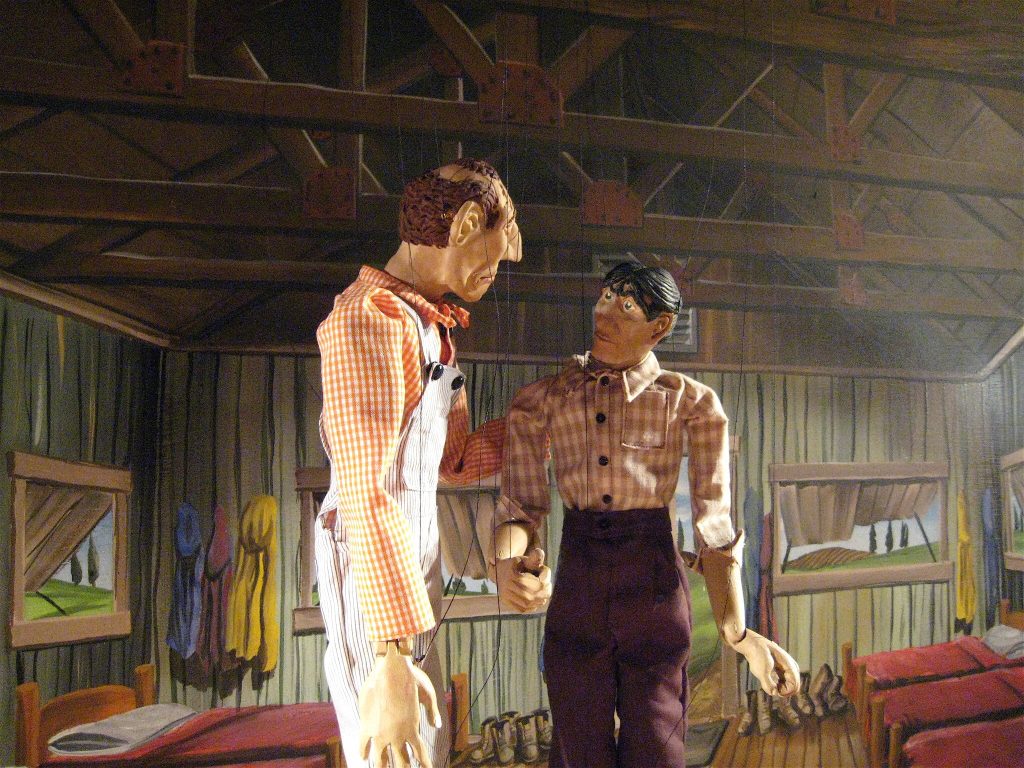
Lennie & George from Of Mice and Men (Performed in 2012)

